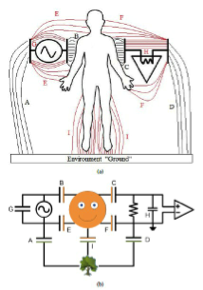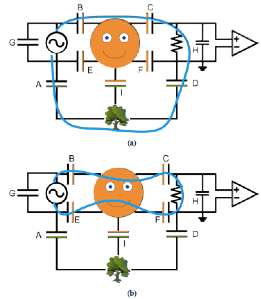Body Coupled Communication
- Category: Circuits & Systems, Medical Electronics
- Tags: charles sodini, grant anderson
Body coupled communication (BCC) uses the conductive tissues in the body as a channel to form a body area network (BAN). BCC is implemented with the transmitter and receiver each having two electrodes. These electrodes make capacitive links with the human body and the environment as shown in Figure 1(a). Figure 1(b) shows the circuit diagram of these capacitive links. There have been two ways to implement BCC; one will be called “traditional” (T-BCC) and the other “wave-guide” (W-BCC). The desired current path used in T-BCC is through both the body and the environment (see Figure 2(a)), while the desired current path for W-BCC is solely through the body (see Figure 2(b)).
Whether or not the dominant current path is T-BCC or W-BCC is important regarding the feasibility of implants using BCC. Implanted devices would not be able to utilize T-BCC because they cannot make a capacitive link with the environment. It is also important for purely external BCC because it would determine whether or not the impedance of the capacitive links “E” and “F” should be minimized or maximized. W-BCC is being investigated to determine if it is indeed the main current path allowing implants to use BCC to send data outside the body.
- Figure 1: (a) The electric field lines made among the transmitter, receiver, body, and environment. (b) The circuit diagram for (a).
- Figure 2: (a) The dominant current path for T-BCC. (b) The dominant current path for W-BCC.
- T. G. Zimmerman, “Personal Area Networks (PAN): Near-field intrabody communication,” Master’s thesis, MIT Media Laboratory, 1995. [↩]
- S.-J. Song, N. Cho, S. Kim, et al., “A 0.9V 2.6mW Body-Coupled Scalable PHY Transceiver for Body Sensor Applications,” ISSCC Dig. Tech. Papers, pp. 366-367, Feb. 2007. [↩]
- A. Fazzi et al., “A 2.75mW wideband correlation-based transceiver for body-coupled communication” ISSCC Dig. Tech. Papers, pp. 204-205, Feb. 2009. [↩]

